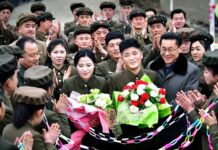Suspicions that North Korea maintains a stockpile of
biochemical weapons have been raised since the Malaysian authorities confirmed
that VX, a deadly nerve agent, was used to kill Kim Jong Nam.
VX is the most powerful nerve agent known and is classified
as a weapon of mass destruction.
Some estimate that North Korea has stockpiled approximately
5,000 tons of chemical weapons, but this takes into account only the material
manufactured from early 2010. Considering that the country was reported to have
begun manufacturing chemical weapons since the 1970s, the total amount
possessed is likely to be higher.
Decades ago, Dr. Ri Sung Gi was a renowned chemist who
invented Vinalon, a lightweight synthetic fiber, ushering in a small textile
revolution in North Korea. However, reports allege that Kim Il Sung secretly
ordered Dr. Ri to kickstart the country’s biochemical weapons program, with the
chemist having no choice but to comply.
Dr. Ri died while being criticized by many North Korean
residents, rather than being recognized for his contribution to the country’s
economic development.
The reason for the criticism is that in 1989, there was an
incident in which scores of people died instantly or collapsed in the streets
of Sunchon City, South Pyongan Province, and were transported to hospital. I
arrived in the city the next day and was unaffected, but at the time, all
hospitals in Sunchon City and neighboring Pyongsong were full of injured
people, some of whom were even transferred to Pyongyang.
It was later revealed that some local residents
inadvertently precipitated the incident after climbing onto a tank car
stationed at Sunchon Railway Station. They opened the lid, thinking it
contained diesel oil [to siphon off] but it was in fact a toxic precursor
purportedly for use in the manufacture of biochemical weapons.
Soon after the lid was opened, a cloud of yellow gas spread
into the air, and the people nearby immediately collapsed, with hundreds of
people dying at the scene in the span of only a few hours. Thousands were
injured and left with gruesome side effects, but the authorities primarily
focused on preventing the news from spreading to other regions.
Now, 30 years on, state institutions including the Hamhung
branch of the State Academy of Sciences are reportedly continuing their
research into the development of chemical weapons.
The North Korean government transformed its domestic
chemical industry into a producer of weapons of mass destruction for its own
nefarious purposes. The international community must respond appropriately to a
regime that resorts to the use of a weapon of mass destruction in a public
place to secure its reign of terror.




















